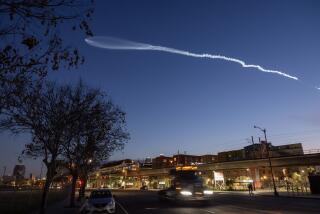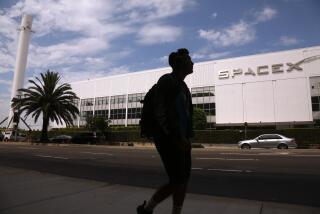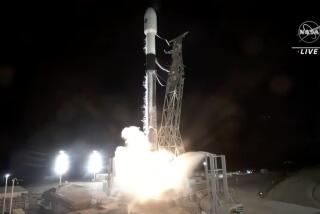NASA Officials Defend Methods, Score Engineers
- Share via
HUNTSVILLE, Ala. — Key NASA officials who could have stopped the space shuttle Challenger from roaring aloft defended their launch decision methods Friday while attempting to diminish the credibility of engineers who warned of a possible catastrophe at liftoff.
The four officials, joined by the director of Huntsville’s Marshall Space Flight Center, challenged the deep concerns of aerospace engineers who warned against the flight, criticized shuttle contractors who leaked information to the press and said NASA’s launch criteria should not be taken to task because it had always worked before.
The five NASA officials spoke at the Marshall Center the day after William P. Rogers, the chairman of the presidential commission investigating the worst space disaster in history, denounced the National Aeronautics and Space Administration as having a “clearly flawed” decision-making process.
The tangled process serves to “eliminate the element of good judgment and common sense,” Rogers said in summarizing three days of hearings in which all five Marshall officials testified.
But Marshall Director William R. Lucas and his four colleagues, all of whom had testified before the commission, told reporters here that they believed the process was a good one, despite the shuttle explosion and testimony that objections to the launch by engineers at Morton Thiokol Inc., the manufacturer of the boosters, did not reach high-level NASA officials.
“I do not view the process to be flawed,” he said.
Will Study All Facets
At a separate press conference in Houston, Jesse W. Moore, the man who gave the final order to launch Challenger, said he is not ready to agree that NASA’s decision-making process is flawed. However, the space agency will re-examine all facets of its command structure in the nine to 18 months before the next shuttle flight, he said.
Engineers for Morton Thiokol testified during the hearings that they were unanimous in their concern for the safety of the Challenger mission because of sub-freezing temperatures the night before liftoff. They said they feared the cold weather would weaken the seals that joined the components of the boosters. It was those objections that did not reach high-ranking NASA officials.
But Lawrence B. Mulloy, the director of Marshall’s solid rocket booster project, said parallel lines of communications existed between Morton Thiokol engineers and their counterparts at NASA. He said that if major concerns existed, they could have easily been conveyed through that routing, rather than going up the chain of command and then on to NASA.
“None of these (NASA) engineers knew that level of concern existed,” he said.
Criticizes Thiokol
Stanley R. Reinartz, the manager of the Marshall special projects office and the man who acknowledged to the presidential commission that he did not pass on Morton Thiokol’s reservations to higher authorities, also came down on the booster manufacturer.
“I found it rather strange that Morton Thiokol was perfectly ready to launch on the morning of Jan. 27 as we were counting down and I believe the temperature was about 40 degrees,” he said. “And 12 hours later, they come to us with initial information that we shouldn’t launch below 53 degrees and I don’t believe I’ve had an explanation from Morton Thiokol on those two differences,” he said.
(A Thiokol official in Utah, while declining to address the issue on the record, told the Associated Press that 40 degrees was within the operating specifications of the booster, but that overnight temperatures on Jan. 28, in the mid-20s, might have raised an additional “danger flag” with Thiokol engineers.)
(Commission spokesman Mark Weinberg said the panel had “no response” to the rebuttal offered by officials at Marshall.)
Reinartz also defended his decision not to pass on the Morton Thiokol fears to other NASA officials.
‘At Every Level’
“The pyramid approach says that everything cannot go to the top of an organization,” he said. “Decisions have to be made at every level.”
Judson A. Lovingood, the deputy manager of the shuttle projects office, also defended the system, saying it had been in effect since the space program began. He said the press had distorted the issues in the case because it did not understand them. Reinartz said it was unfortunate that stories had been leaked to the press before the facts were presented to the commission.
Lucas, who was on the defensive through most of his press conference, said it was impossible for him to know everything that was going on at Marshall.
“I cannot possibly know the details of each and every one of these projects,” he said, adding that he had delegated authority to responsible individuals. “If that’s a fault, that’s a fault,” he said.
Refuses to Speculate
George Hardy, Marshall’s director of science and engineering, refused to speculate on the possible cause of the crash, while at the same time dissociating himself from any decisions by his subordinates to go ahead with the launch.
Lucas also declined to discuss probable causes, but said a joint in Challenger’s starboard solid rocket booster was emerging as the “first offender,” or prime suspect, in the investigation. He also said that NASA was examining the possibility that ice inside the booster’s seal might have led to the “blow-by” that destroyed Challenger.
Hardy also said one trouble spot being examined was the possibility of water seeping between two seals on the booster, then expanding when ice formed in the freezing morning air. He said water was found in a previous shuttle booster when it was being dismantled, a fact that was not discovered until the investigation into the Challenger crash began.
“Water itself couldn’t do anything and I think, frankly, there’s a low probability that ice would do anything,” he said. “However, it is being investigated.”
More to Read
Sign up for Essential California
The most important California stories and recommendations in your inbox every morning.
You may occasionally receive promotional content from the Los Angeles Times.













